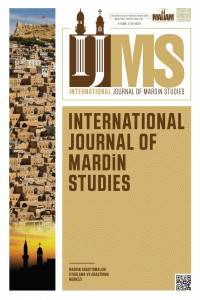Anadolu’daki Kilim Motiflerinin Gümüş-Telkari Alanına Uygulanması: Mardin Olgunlaşma Enstitüsü Örneği
Abstract
Dünyanın farklı bölge ve kültürlerinde pek çok insan kimi zaman gereksinimden, kimi vakit de dekoratif amaçlı olarak hayatlarında her türlü dokuma ürünlerini kullanmışlardır. Bu dokuma ürünlerinden biri de kilimlerdir. Kilim; tezgâhta atkı ipliklerinin, çözgü iplikleri arasından geçirilmesiyle, el ile dokunan, halıdan daha ince ve tüysüz olan renkli ve nakışlı bir yün dokumadır. Çağımızda değişen teknoloji ile beraber üretim yöntemleri değişmiş olsa da kullanılan motiflerin anlamı asıllarını yüzyıllardır koruyarak günümüze kadar gelmeyi başarabilmiştir. Kilimlerde kullanılan motifler bazen kötü güçlerden korunmak için, bazen dile getirilemeyen hisleri sembolleştirmek için, bazen de iyi şans getirmesi için dokundukları anlaşılmaktadır. Anadolu coğrafyasında üretilen kilimler genellikle kadınlar tarafından dokunmaktaydı. Kadının hislerini sözlü olarak anlatamadığı yerde motiflerin dilini kullandığı bilinmektedir. Motiflerin manaları, vermek istenilen mesaj birçok araştırmacı için çalışma konusu olmuştur. Günümüzde bu motifler, taşıdıkları anlamlar ile kültürel mirasın bilincinin yanında sanatsal olarak pek çok alanda uygulanmasına ve yeni sanat eserlerinin ortaya çıkmasında esin kaynağı olmuştur. Bu alanlardan biri de gümüş-telkâri sanatıdır. Bu bağlamda çalışma konusu Mardin Olgunlaşma Enstitüsü bünyesinde yer alan Takı imalatı atölyesinde kilim motiflerinden üretilen takılar oluşturmaktadır. Çalışmada kilim motiflerinin taşıdığı anlamlarından bahsedip gümüş telkâri alanına yansıtılan örnekleri görselleriyle aktarılmaya çalışılacaktır. Bu çalışmadaki amaç yüzyıllarca asıllarını koruyarak günümüze gelen kilim motiflerini yer döşemesi dışında insan bedeni üzerinde takı işlevinde üretilip yaygınlaşmasını sağlayarak gelecek kuşaklara aktarmaktır.
References
- Akpınarlı- Arlsan (2018). Kuş motifinin özellikleri ve kuş motifli döşeme altı halıları, Uluslararası Folklor Akademi Dergisi, Cilt 1, Sayı 3, 273-286.
- Baydaş, Ö. G. (2007). Diyarbakır ve Mardin’deki Tarihi Kamu Yapıları, Yayınlanmamış Doktora Tezi Yüzüncü Yıl Üniversitesi Sosyal Bilimler Enstitüsü Sanat Tarihi Anabilim Dalı.
- Dizel, T. ve Özkaya, K., (2019). "Geleneksel Türk Motiflerinin Bazı Örneklerinin Marketri (Kakmacılık) Tekniğiyle Mobilya ve Ahşap Yüzeylerde Uygulanması” Pamukkale Üniversitesi Sosyal Bilimler Enstitüsü Dergisi, sayı 37, s. 261-279.
- Durul, Y. (1977). Yörük Kilimleri Niğde Yöresi, İstanbul.
- Erbek, M. (2020), Çatalhöyükten Günümüze Anadolu Motifleri, Kültür Bakanlığı, Ankara.
- Gülçayır, S. (2013). Resmî Eğitim Süreçlerinde Gelenek Aktarımı Ve Kadın Ankara Ve Trabzon Olgunlaşma Enstitüsü Örneği, Yayınlanmamış Doktora Tezi, Ankara Üniversitesi Sosyal Bilimler Enstitüsü Halk Bilim Anabilim Dalı.
- Gürçayır, S. (2017). Teke Seçkinleştirilen El Sanatları ve Geleneğin Sınırları: Olgunlaşma Enstitüleri Örneği, milli folklor dergisi, yıl 29,sayı116, s.58-72. Uğurlu, A. (1997). Eczacıbası Sanat Ansiklopedisi, “Kilim” Mad. c.2, İstanbul.
- Kırzıoğlu, N.Görgünay; (1983). “Bardız Kilimleri” II. Milletlerarası Türk Folkloru Bildirileri-V 1983.
- Sürür, A. (1992). “Türk Tekstil Sanatlarında Kuş Motifi”, IV. Milletlerarası Türk Halk Kültürü Kongresi Bildirileri, V. Cilt, Maddi kültür, Ankara 1992, s. 203.
THE APPLICATION OF KILIM MOTIFS IN ANATOLIA TO THE SILVER-FIELKARI AREA: THE CASE OF MARDIN MATURATION INSTITUTE
Abstract
Many people in different regions and cultures of the world have used it in their lives, sometimes for pleasure and sometimes for use. Rug is one of these weavings. Rug; It is a colorful and embroidered wool weaving, woven by hand by passing the weft threads between the warp threads on the loom, thinner and hairless than the carpet. Although the production methods have changed with the changing technology in our age, the meaning of the motifs used has been able to survive until today by preserving their originals for centuries. It is understood that the motifs used in the rugs are sometimes woven to protect from evil forces, sometimes to symbolize feelings that cannot be expressed, and sometimes to bring good luck. Rugs produced in Anatolian geography were generally woven by women. It is known that where the woman cannot express her feelings verbally, she uses the language of motifs. The meanings of the motifs and the desired message have been the subject of study for many researchers. Today, these motifs have been a source of inspiration for the awareness of cultural heritage with the meanings they carry, as well as the application of them artistically in many fields and the emergence of new works of art. One of these fields is the art of silver filigree. In this context, the subject of the study is the jewelry produced from rug motifs in the jewelry manufacturing workshop within the Mardin Maturation Institute. In this study, we will talk about the meanings of rug motifs and try to convey the examples reflected in the silver filigree area with their visuals. The aim of this study is to transfer the rug motifs, which have survived to the present day by preserving their originals for centuries, to the next generations by producing and spreading them as jewelry on the human body, apart from the floor covering.
References
- Akpınarlı- Arlsan (2018). Kuş motifinin özellikleri ve kuş motifli döşeme altı halıları, Uluslararası Folklor Akademi Dergisi, Cilt 1, Sayı 3, 273-286.
- Baydaş, Ö. G. (2007). Diyarbakır ve Mardin’deki Tarihi Kamu Yapıları, Yayınlanmamış Doktora Tezi Yüzüncü Yıl Üniversitesi Sosyal Bilimler Enstitüsü Sanat Tarihi Anabilim Dalı.
- Dizel, T. ve Özkaya, K., (2019). "Geleneksel Türk Motiflerinin Bazı Örneklerinin Marketri (Kakmacılık) Tekniğiyle Mobilya ve Ahşap Yüzeylerde Uygulanması” Pamukkale Üniversitesi Sosyal Bilimler Enstitüsü Dergisi, sayı 37, s. 261-279.
- Durul, Y. (1977). Yörük Kilimleri Niğde Yöresi, İstanbul.
- Erbek, M. (2020), Çatalhöyükten Günümüze Anadolu Motifleri, Kültür Bakanlığı, Ankara.
- Gülçayır, S. (2013). Resmî Eğitim Süreçlerinde Gelenek Aktarımı Ve Kadın Ankara Ve Trabzon Olgunlaşma Enstitüsü Örneği, Yayınlanmamış Doktora Tezi, Ankara Üniversitesi Sosyal Bilimler Enstitüsü Halk Bilim Anabilim Dalı.
- Gürçayır, S. (2017). Teke Seçkinleştirilen El Sanatları ve Geleneğin Sınırları: Olgunlaşma Enstitüleri Örneği, milli folklor dergisi, yıl 29,sayı116, s.58-72. Uğurlu, A. (1997). Eczacıbası Sanat Ansiklopedisi, “Kilim” Mad. c.2, İstanbul.
- Kırzıoğlu, N.Görgünay; (1983). “Bardız Kilimleri” II. Milletlerarası Türk Folkloru Bildirileri-V 1983.
- Sürür, A. (1992). “Türk Tekstil Sanatlarında Kuş Motifi”, IV. Milletlerarası Türk Halk Kültürü Kongresi Bildirileri, V. Cilt, Maddi kültür, Ankara 1992, s. 203.
Details
| Primary Language | Turkish |
|---|---|
| Journal Section | Research Articles |
| Authors | |
| Publication Date | April 22, 2022 |
| Published in Issue | Year 2022 Volume: 3 Issue: 1 |
International Journal of Mardin Studies is licensed under a Creative Commons Attribution-NonCommercial 4.0 International License (CC BY NC).


